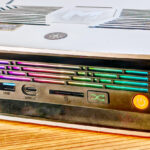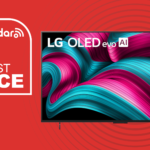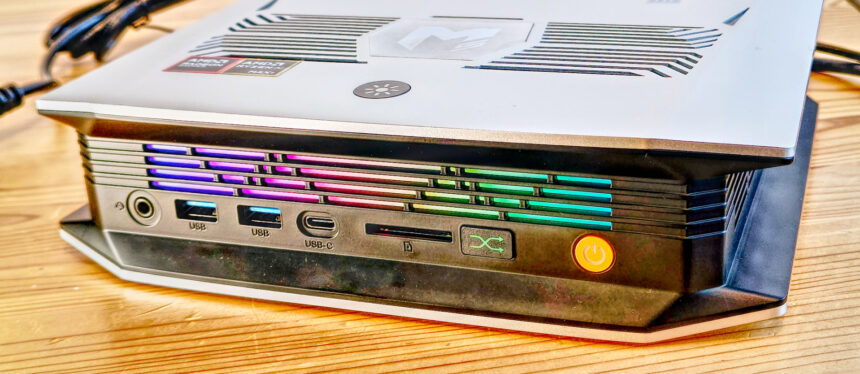Why you can trust TechRadar
We spend hours testing every product or service we review, so you can be sure you’re buying the best. Find out more about how we test.
Bosgame M5 AI: 30-second review
With its advanced AI capabilities and sleek design, the Bosgame M5 AI perched eagle-like to redefine the standards of performance and versatility in the market.
One of the first mini systems we’ve seen using the new AMD Ryzen AI Max+ 395 processor, which breaks new ground in processing power and integrated video performance.
The silicon used here is a significant leap forward, as it enables the device to expand into markets that were previously exclusive to desktop PCs. Professionals, gamers, and tech enthusiasts can now enjoy the same level of performance and power on the go, without being tethered to a bulky desktop setup. This portability does not come at the expense of performance, as the Bosgame M5 AI is equipped with cutting-edge hardware that ensures seamless multitasking, fast processing speeds, and exceptional graphics capabilities.
When compared to other products in this sector, the Bosgame M5 AI stands out for several reasons. Firstly, its AI capabilities are unparalleled. The device is designed to learn and adapt to the user’s preferences and habits, making it more intuitive and user-friendly over time. This level of personalisation is not commonly found in other products, giving the Bosgame M5 AI a distinct edge.
Secondly, the Bosgame M5 AI boasts a sleek and modern design that is both aesthetically pleasing and functional. Its compact size makes it easy to carry around, while its robust build ensures durability.
In terms of performance, the Bosgame M5 AI is a powerhouse. It is equipped with the latest processors, ample RAM, and high-speed storage options, making it capable of handling even the most demanding tasks with ease. Whether you are editing videos, playing graphics-intensive games, or running complex simulations, the Bosgame M5 AI delivers top-notch performance consistently.
Moreover, the Bosgame M5 AI is designed with the future in mind. It supports the latest connectivity options, including Wi-Fi 7 and USB4, ensuring that it remains compatible with emerging technologies. This forward-thinking approach sets it apart from other products that may become obsolete as technology evolves.
As you might expect for a machine on its own level, this isn’t a budget option, but it isn’t costly either.
With its unique combination of compact design, expandability and power, the Bosgame M5 AI is obviously one of the best mini PC machines available. Still, other makers are already progressing their plans with this platform.
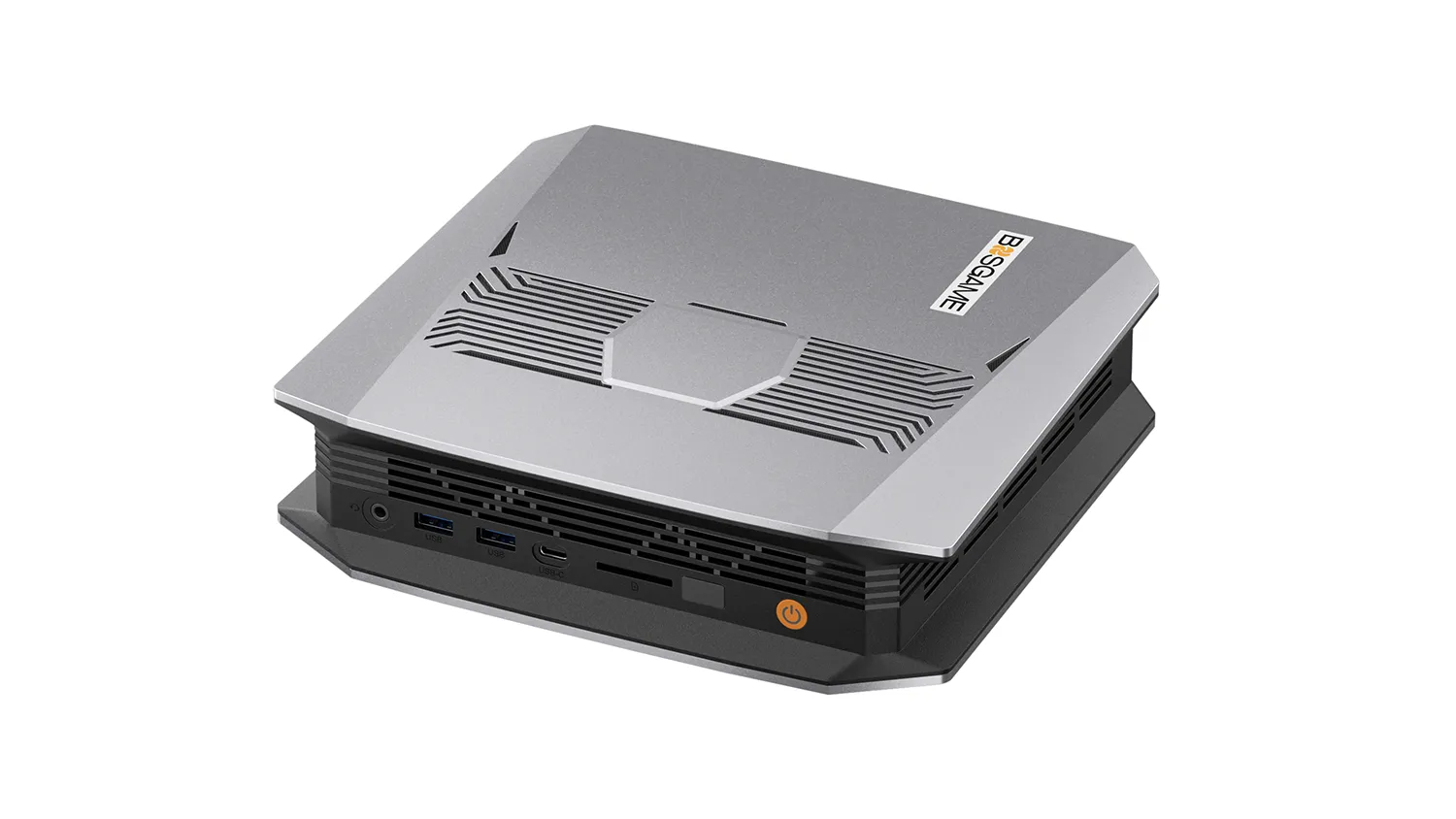
Bosgame M5 AI: Price and availability
- How much does it cost? From $1490/£1105
- When is it out? Out now
- Where can you get it? Direct from the makers
The Bosgame M5 AI Mini Desktop is available in various regions via the maker’s website, with two basic SKUs that are differentiated only by the amount of RAM.
The cheapest option has 96GB of RAM and 2TB of storage, priced at $ 1,489.14, while its 128GB counterpart, also with 2TB of storage, costs $1,699.76 in the USA.
The UK prices for those two options are £1,103 and £1,259. And in the EU, € 1,277.65 and € 1,458.35 are the asking prices.
That makes this one of the most expensive mini PC systems we’ve covered at TechRadar Pro, but cutting-edge technology often carries a premium.
However, this isn’t the only system using this platform. GMKtec has its EVO-X2 design, and Beelink has the GTR9 Pro.
The GMKtec EVO-X2 with 128GB and 2TB is $1999, and the Beelink GTR9 Pro of the same spec is $1985. In comparison, that makes the Bosgame M5 AI something of a bargain.
And, those two alternative products aren’t shipping yet, both being on pre-order.
We can only hope that with more competition, AI Max+ 395 systems drop to around $1500 in the next few months.
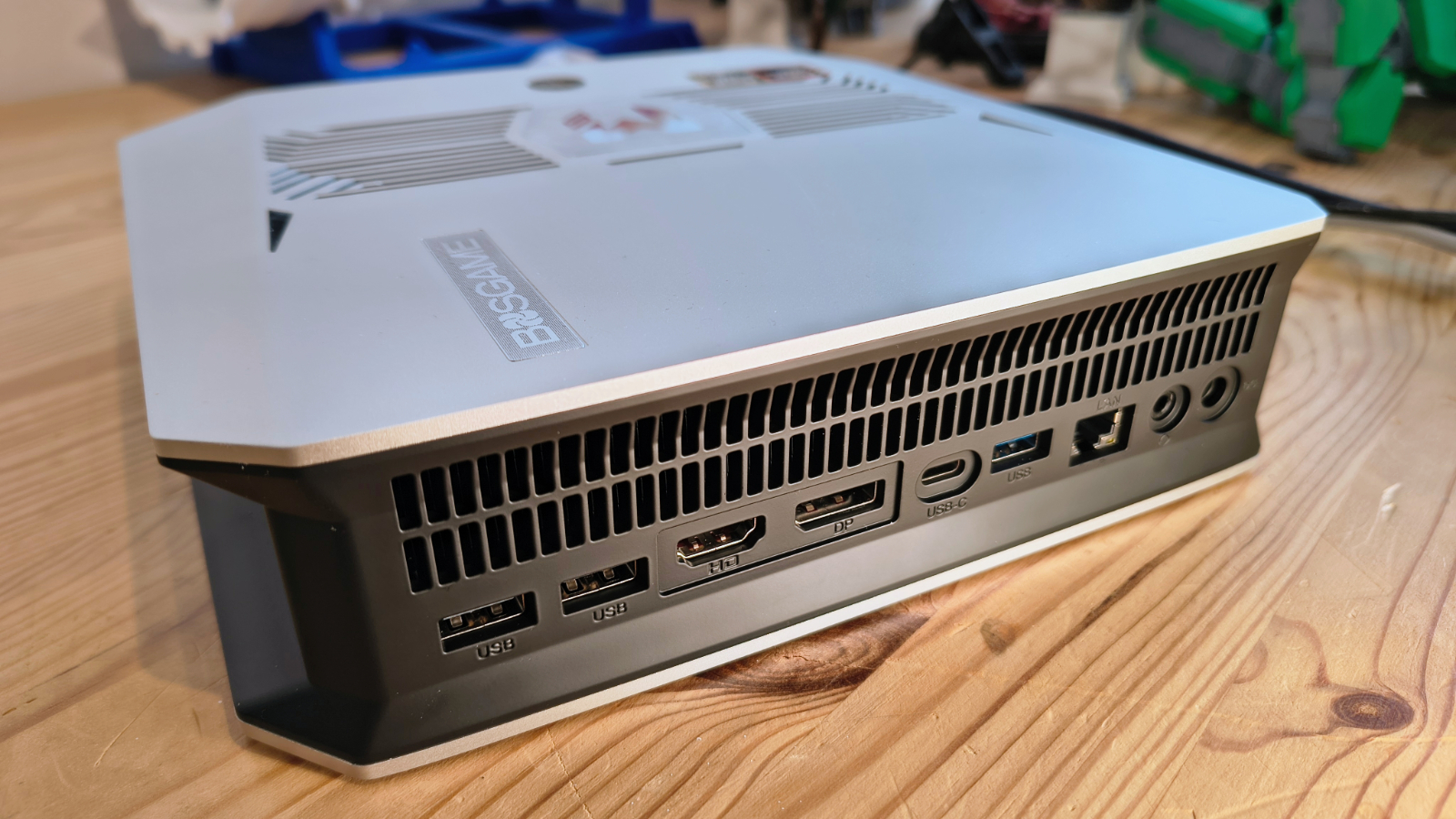
Bosgame M5 AI: Specs
|
Item |
Spec |
|---|---|
|
CPU |
AMD Ryzen AI Max+ 395, 16 cores, 32 threads |
|
GPU |
Integrated Radeon 8060S with 40 RDNA 3.5 GPU cores |
|
RAM |
96GB/128GB LPDDR5X at 8000MHz |
|
Storage |
2TB PCIe 4.0 SSD |
|
Expansion |
2 x M.2 slots |
|
Ports |
2 x USB4 Type-C, 3 x USB 3.2 Gen2, 2 x USB 2.0, 1 x HDMI 2.1, 1 x DisplayPort 1.4, 2 x 2.5Gbps LAN, 1 x microSDXC card reader, 2 x 3.5mm audio |
|
Networking |
Wi-Fi 7, Bluetooth 5.2 |
|
OS |
Windows 11 Pro |
|
Base Power |
65W |
|
PSU |
150W external power adapter |
|
Dimensions |
200mm x 200mm x 60mm |
Bosgame M5 AI: Design
- Larger than a NUC
- Metal construction
- Performance button
- Access panel
The Bosgame M5 AI isn’t a NUC-sized mini system, or even close.
It’s a slightly curious 200mm square 50mm thick sandwich with an aluminium case that’s silver on the top and bottom and black in the middle.
Angling on the corners gives it a games console vibe, and it comes with a foot that enables the machine to be placed vertically. Feet on the underside also allow it to go flat, but Bosgame didn’t make any VESA mounting for it to be attached to a monitor.
The metal walls have numerous slots in them, indicating that cooling was a concern of the designers, and fans pump air through them to help keep temperatures within reasonable limits.
The front has the standard USB ports, with one USB4 and two USB 3.2 Gen 2, an audio jack, power button, SD card 4.0 reader and a performance button.
Pressing the performance button cycles through three modes with a colour graphic on the screen to show which one you are in. The green flower icon shows the machine is set to silent, the amber icon shows that performance and noise are in balance, and there is a red performance mode that I used for benchmarking.
Interestingly, it hardly made a sound in balanced mode, and even in performance mode, it wasn’t exceptionally audible until the system was heavily benchmark-stressed.
On the rear is another USB4, another USB 3.2 Gen 2, HDMI 2.1, DisplayPort 1.4, a second audio jack and a single 2.5GbE LAN port. On such a powerful machine, a 10GbE LAN port might have been expected, but you could always add one of those using one of the USB4 ports.
By subverting the USB4 ports and using both the HDMI and DisplayPort outputs, it is possible to drive four monitors from this system.
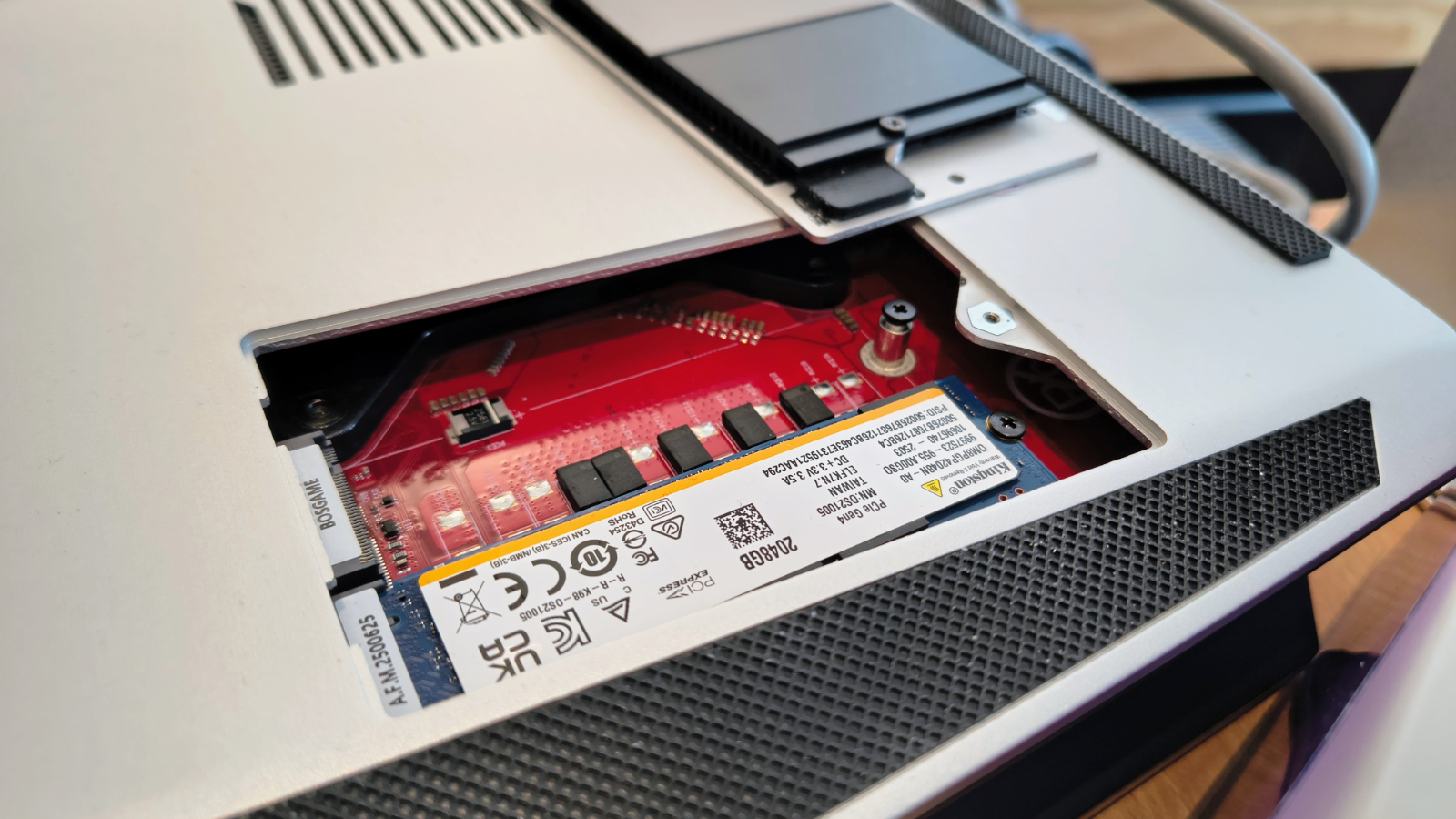
Most mini systems these days disassemble for internal access, but the construction of this one makes that a much less desirable exercise. To avoid users dismantling it, Bosgame engineered an access panel on the underside.
Removing a single tiny screw will open this panel, revealing the two full-sized M.2 slots, one being occupied by a 2TB Kingston drive pre-installed with Windows 11 Pro.
There are no memory slots, as the 8000MHz DDR5 used in this system is soldered to the mainboard, which is something to consider when you choose a 96GB or 128GB model.
The only other external feature of note is a touch-sensitive button on the top that activates an RGB lighting system for the front facia. Conveniently for business users, this is off by default, but if you want some colourful lighting, it is merely a touch away.
Overall, the designers of this machine tried to be different without alienating the potential customer base, and generally succeeded.
Bosgame M5 AI: Features
- AMD Ryzen AI Max+ 395
- DDR5-8000 memory
- Radeon 8060S GPU
The AMD Ryzen AI Max+ 395 is a powerhouse designed to meet the demands of modern computing, particularly in the realms of AI, gaming, and professional workloads. It boasts 16 cores and 32 threads, has a standard clock speed of 3GHz, but can turbo boost up to 5.1GHz. The high core and thread count make it ideal for multitasking, running complex simulations, and handling large datasets.
The Ryzen AI Max+ 395 is not just about raw power; it also integrates advanced AI capabilities, making it a perfect choice for developers and researchers working on machine learning and AI projects.
When you compare this to the best Intel is offering with the Core Ultra 200 series, there is no point of intersection. With the Arrow Lake-H generation, Intel offers sixteen cores and threads, whereas AMD’s sixteen Zen 5 cores can process thirty-two threads simultaneously. But, whereas Intel has only six performance cores, the rest are for efficiency, all of the AMD cores can be performance.
It’s worth noting that these are both mobile chips meant for laptop use, but the Ryzen AI Max+ 395 seems much better suited to the less power-limited environment of a mini PC.
When it comes to memory technology, the Bosgame M5 AI Mini PC does not disappoint. It supports up to 128GB of LPDDR5X RAM, clocked at an impressive 8000MHz. LPDDR5X technology is known for its low power consumption and high efficiency, making it perfect for a compact system like the M5. The memory is dynamically shared with the GPU, enhancing both multitasking and graphics performance with increased bandwidth.
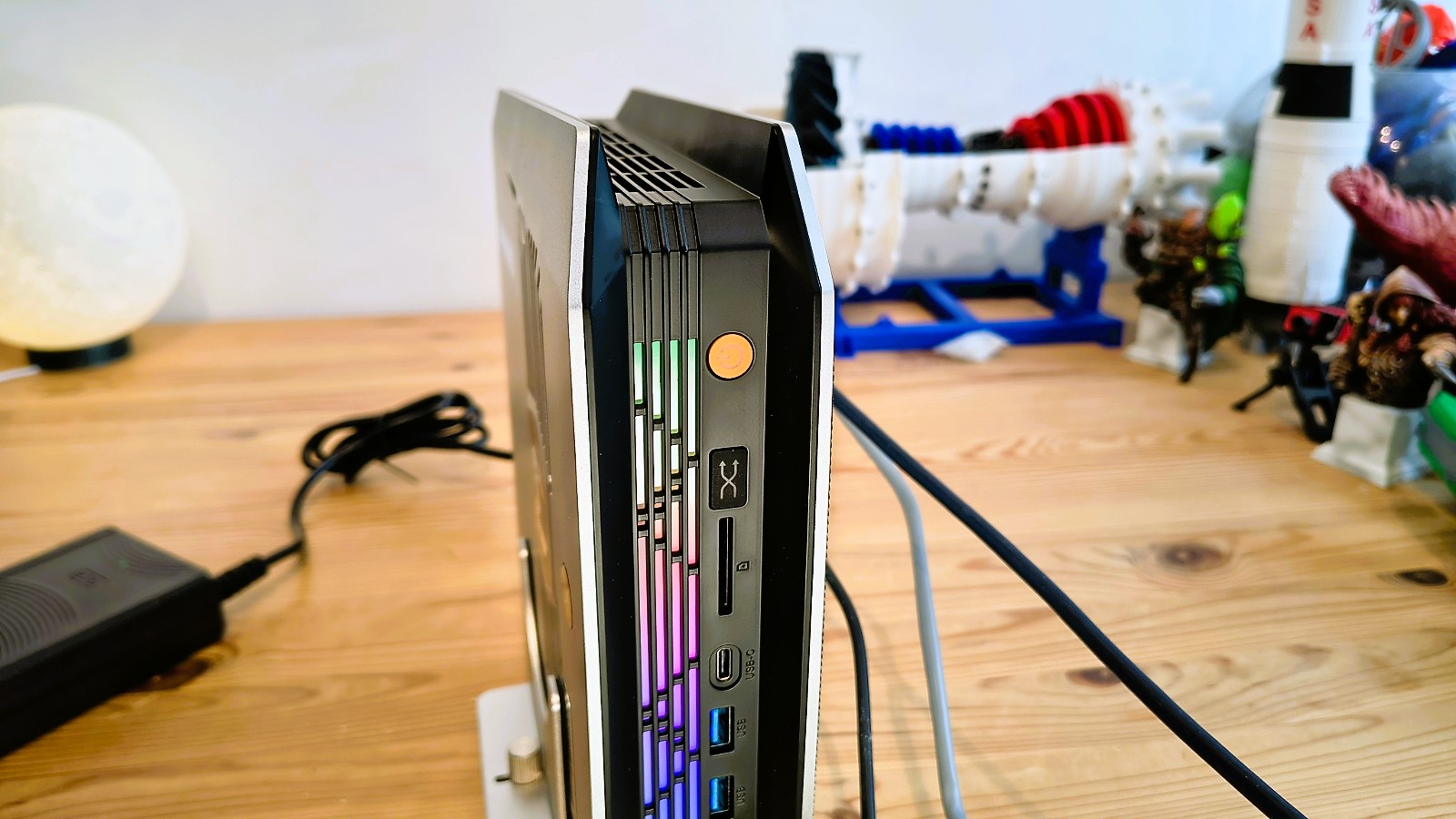
The integrated Radeon 8060S GPU is, for this reviewer, the standout feature of the Bosgame M5 AI Mini PC. Based on AMD’s RDNA 3.5 architecture, this GPU comes with 40 compute units and delivers performance comparable to an RTX 4060 mobile variant.
This makes it capable of handling next-gen gaming and high-end graphics tasks. The Radeon 8060S is designed to provide smooth visuals and powerful computing without the need for a dedicated GPU. This is particularly beneficial for users who need a compact system without compromising on graphics performance. The GPU also supports advanced AI workloads, making it a versatile choice for both gaming and professional applications.
To put this in perspective, the latest Intel chips I’ve tested, the Intel Core Ultra 9 285H and Arc 140T GPU, are rated at 99 peak TOPS, with the NPU offering 48 TOPS. This falls dramatically short of the 126 TOPS that the Ryzen AI Max+ 395 can muster. While the AMD NPU is only 50 TOPS, as an AI platform, the Ryzen AI Max+ 395 is head and shoulders above its Intel counterpart.
Overall, the Bosgame M5 AI Mini PC is a compact yet powerful system that excels in processor performance, memory technology, and GPU capabilities. Whether you are a developer, gamer, or professional, this mini PC offers the performance and versatility you need to tackle any task.
Bosgame M5 AI: Performance
|
Mini PC |
Header Cell – Column 1 |
Bosgame M5 AI |
GMKtec EVO-T1 |
|---|---|---|---|
|
CPU |
Row 0 – Cell 1 |
AMD Ryzen AI 395 Max |
Intel Core Ultra 9 285H |
|
Cores/Threads |
Row 1 – Cell 1 |
16C 32T |
16C 16T |
|
RAM |
Row 2 – Cell 1 |
128GB DDR5-8000 |
64GB LPDDR5 (2x32GB) |
|
Storage |
Row 3 – Cell 1 |
2TB Kingston OM8PGP42048N |
Crucial P3 Plus 1TB |
|
Graphics |
Row 4 – Cell 1 |
Radeon 8060S |
Intel Arc Graphics 140T |
|
3DMark |
WildLife |
70014 |
24893 |
| Row 6 – Cell 0 |
FireStrike |
26917 |
8213 |
| Row 7 – Cell 0 |
TimeSpy |
11317 |
4363 |
| Row 8 – Cell 0 |
Steel Nom Lt. |
11201 |
3436 |
|
CineBench24 |
Single |
115 |
129 |
| Row 10 – Cell 0 |
Multi |
1879 |
1141 |
| Row 11 – Cell 0 |
Ratio |
16.32 |
8.82 |
|
GeekBench 6 |
Single |
2981 |
2973 |
| Row 13 – Cell 0 |
Multi |
17882 |
16097 |
| Row 14 – Cell 0 |
OpenCL |
101915 |
41700 |
| Row 15 – Cell 0 |
Vulkan |
90384 |
38605 |
|
CrystalDisk |
Read MB/s |
4083 |
5198 |
| Row 17 – Cell 0 |
Write MB/s |
3639 |
4726 |
|
PCMark 10 |
Office |
9056 |
7917 |
|
WEI |
Row 19 – Cell 1 |
9.6 |
8.4 |
Buckle up, Intel fans, because things are going to get bumpy on this ride.
For this comparison, I matched the Bosgame M5 AI against one of the best Intel designs, the GMKtec EVO-T1. The EVO-T1 is around $1000 with 64GB of RAM and 2TB of storage, making it a more affordable option. However, we’re testing performance in this section.
To be brutally honest, there is only one single benchmark where the Intel Core Ultra 9 285H traded positively against the AMD Ryzen AI 395 Max, and that was single-core performance on CineBench24.
Every other score is a win for AMD, and some of these victories should worry Intel severely.
GMKtec did put a better NVMe drive in their system, but I could put a much better one in and fix that score easily.
The truly crushing defeats come in anything that’s graphics-related, since the Radeon 8060S is between triple and quadruple the performance of the Intel Arc Graphics 140T. Being able to compete with the mobile version of the RX4060 is genuinely impressive and moves integrated graphics as a whole to an entirely new level.
While I didn’t put the data here, this is the first integrated set that I’ve tested that could run the 3Dmark raytracing tests, Solar Bay and Port Royal.
But what was most disturbing was that I compared it to the system I use to write. That’s an AMD Ryzen 5 3600X desktop system with 32GB of DDR4 and an AMD Radeon RX 6600 XT.
The M5 obliterated that desktop system, achieving just 8134 on 3Dmark Steel Nomad Lite, compared to 11201 on the M5. And, it wasn’t much noisier doing that, even with liquid cooling.
Therefore, I’d probably get more done if I ditched my PC and got an M5.
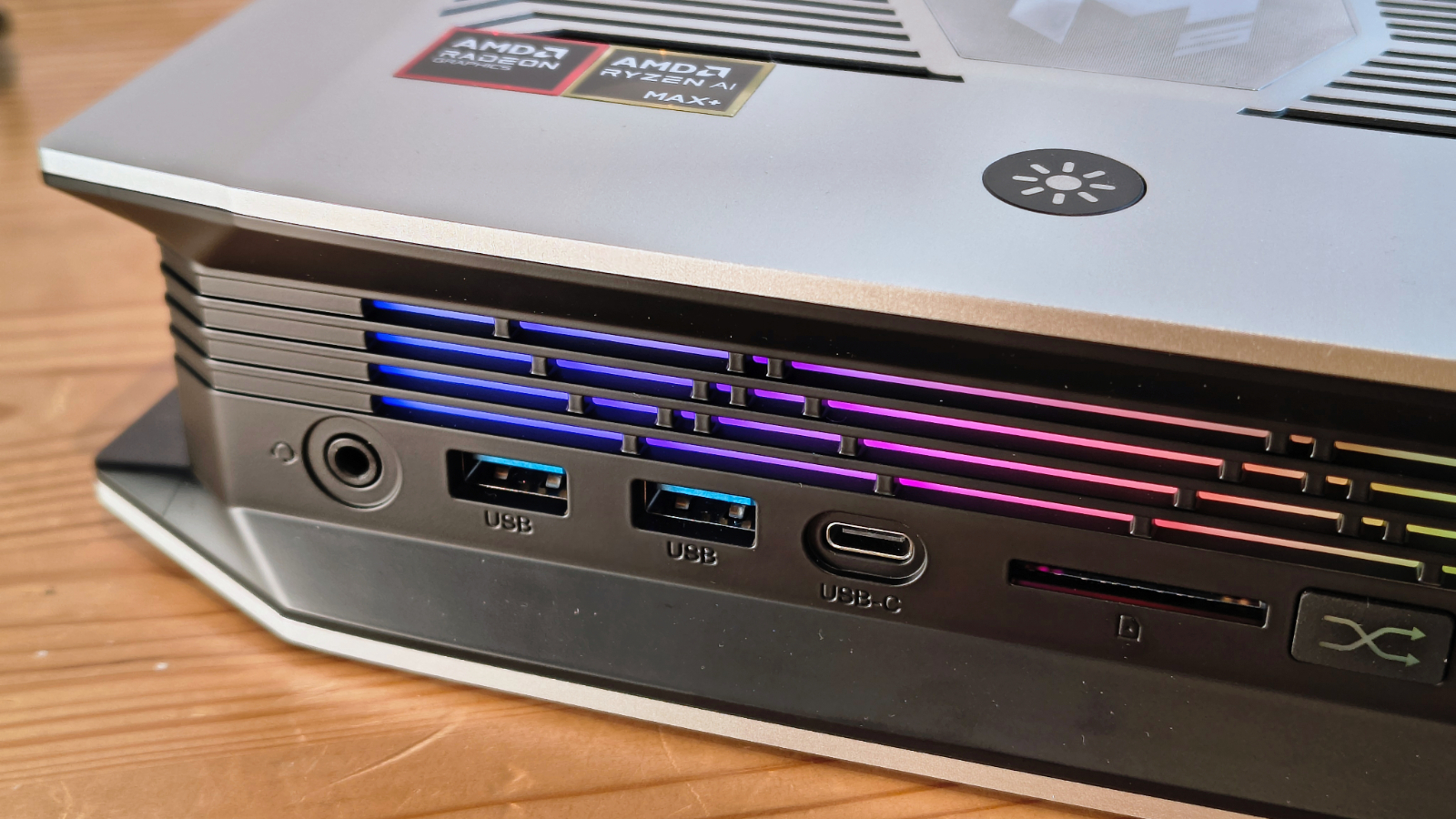
But what left me dumbstruck was discovering that the M5 is faster than the Lenovo ThinkStation P3 Tower I reviewed a while ago, and that’s sold as a Workstation! OK, you could add a high-spec discrete CPU to the Lenovo, and it would be quicker, but with its RTX A2000 12GB graphics card, it gets royally trounced by the Bosgame system.
If power consumption is essential to you, I conducted some basic tests using the 3DMark Steel Nomad Lite bench as the running application. In Silent mode, it consumed about 86W. In Balanced mode, the power increased to 127W, and Performance mode required about 175W. When at idle, the machine took only 50-60W.
Admittedly, that’s more than a typical NUC system, but then this machine gets much more done than a machine that only uses 45W maximum.
It appears that we’ve blindly stumbled over a significant moment in computing development, where the desktop system is revealed to be a paper-tiger, and the future belongs to much smaller installations.
In whatever way some might wish to view these developments, the M5 AI is a beast of a system, irrespective of physical size.
Bosgame M5 AI: Final verdict
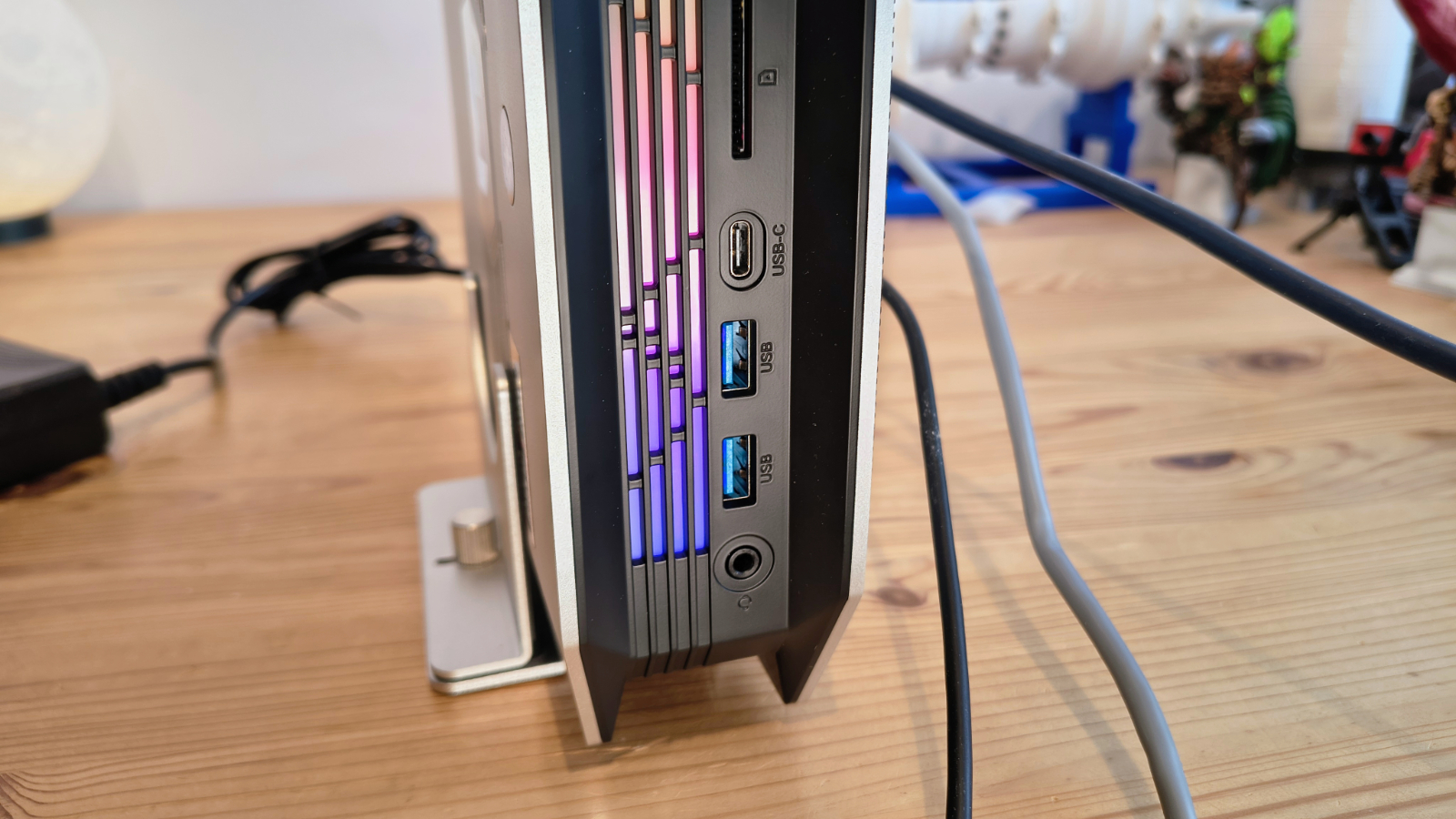
I’ve been complaining about AMD’s failure to deliver its proper RX technology to its integrated GPUs for some time, as the 680M, 780M, and 880M didn’t trace a parabolic curve of performance improvements.
The Radeon 8060S is what I’d been asking for, or more than I thought AMD would provide.
When combined with the Zen 5 architecture of the AMD Ryzen AI 395 Max, the M5 AI creates a performance level that makes even recent desktop systems look poor in comparison.
What Bosgame has delivered is a no-compromise mini system that can be used for CAD, video editing, AI local models, and virtually any other application. Using it for Office applications is probably beneath it, but it can sling a few cycles in that direction.
As for the rest of this system, I’m not a massive fan of the aesthetics, but it’s not weirdly unpleasant either. It has enough USB4 to work with a docking station nicely, and enough USB to connect most things. A second LAN port would have been nice, but with USB4 ports available, it’s not a show stopper.
Should it have had OCulink? Maybe. But the onboard GPU will be good enough for many people, so it’s not a necessity.
At this point, the M5 AI is the breaking edge of a wave that will be rapidly followed by a veritable tsunami of Ryzen AI machines, tearing up the fabric of space and time as we’ve come to understand it.
Those selling Intel mini systems need to be mindful of the coming storm, because not many people are going to want Core Ultra 200 series hardware once they’ve seen one of these in action.
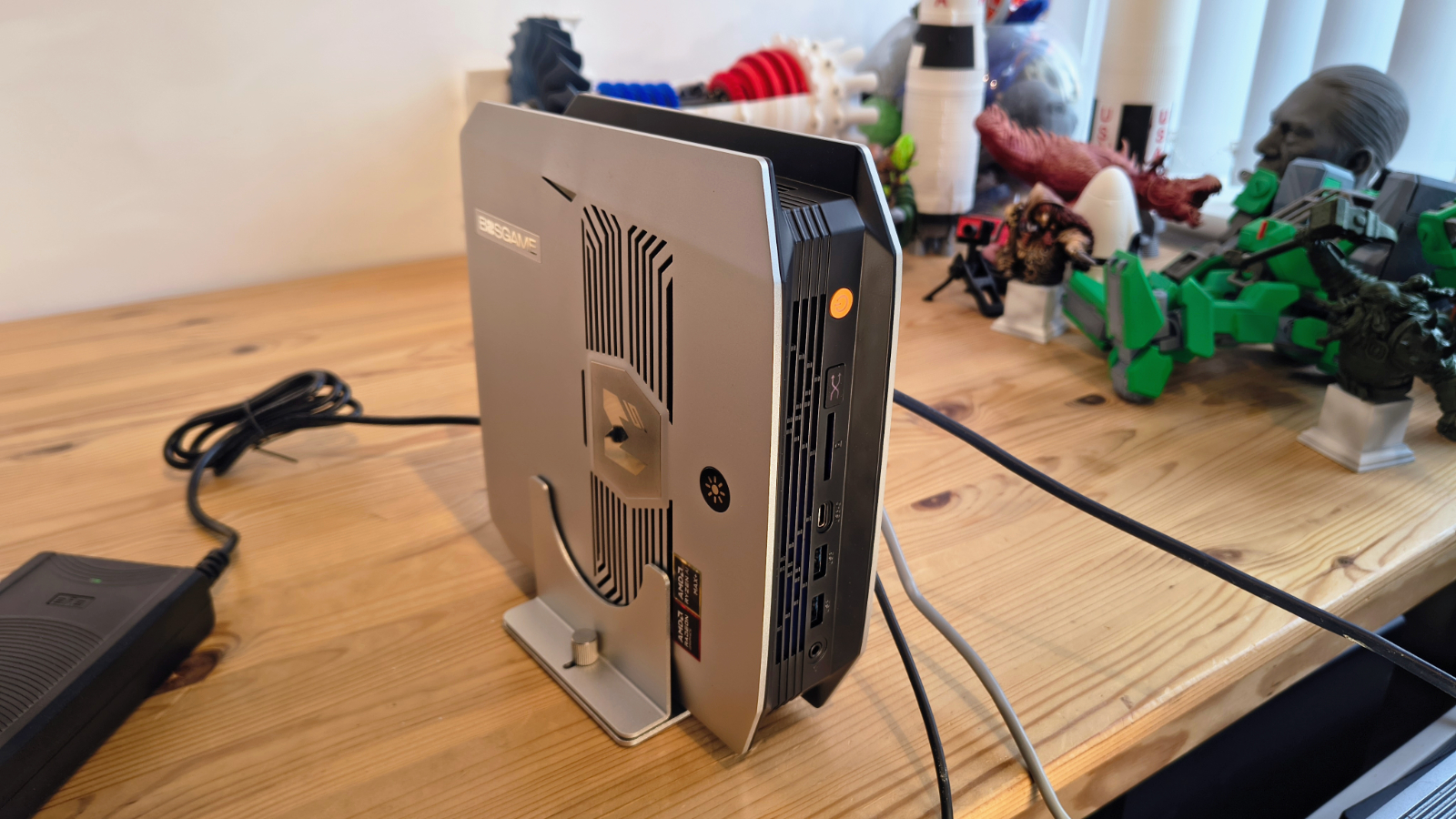
Should you buy a Bosgame M5 AI?
|
Value |
It’s new and not cheap, expectedly |
4 / 5 |
|
Design |
Bigger than a NUC, but smaller than a desktop |
4 / 5 |
|
Features |
16-core CPU, monster integrated CPU, 128GB of DDR5-8000 |
5 / 5 |
|
Performance |
Eats even desktop computers for breakfast |
5 / 5 |
|
Overall |
Simply the most powerful mini system so far |
5 / 5 |
Buy it if…
Don’t buy it if…
Also Consider
For more professional hardware, we’ve reviewed the best business computers and the best business laptops for working on the go.



